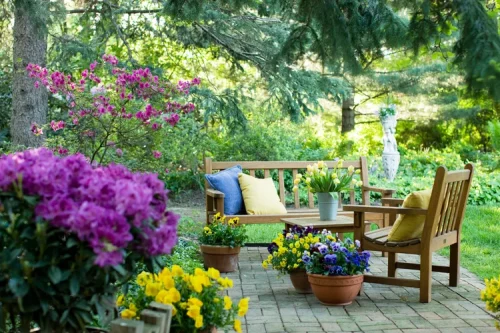Use This Spring Gardening Checklist for a Pretty Landscape All Year

As your garden starts waking up in spring, it’s time to start planting, pruning, and prepping for the growing season ahead.
Just as you give your house a good spring cleaning to freshen it up after a long winter, you can take a similar approach to getting your garden in shape for the warmer months. Tackle all your outdoor tasks like a pro with this spring gardening checklist. It’s divided into early, middle, and late spring tasks to help you pace yourself as you get your flowerbeds, trees, shrubs, and other garden areas ready for the growing season. That way, you’ll be sure to hit each area of your landscape before summer arrives.
Early Spring
Though the official first day of spring is in March, gardeners often go by the weather to decide that spring has started. Think of early spring as the time when temperatures begin trending upward and stay consistently above freezing if you live in a cold climate. In temperate regions, most plants are just about to break dormancy but haven’t started actively growing yet.
1. Clean up flowerbeds.
Clear away dead leaves or any other winter debris from the soil surfaces where you’re planning to plant annual flowers and vegetables. Remove protective winter mulch from around perennials and ornamental grasses (hedge trimmers make it easy to give grass clumps a clean, even look), and cut back last year’s dried foliage. To protect yourself from cuts and scrapes, remember to wear gardening gloves, especially when working with plants with prickly leaves.
2. Divide your perennials.
A good time to divide many perennials is just before spring growth begins. Dividing perennials is a budget-friendly way to add more plants to your garden, or to share extras with friends. It also aids in keeping your existing perennials healthy. After a few years, if your plants grow in a large clump, the middle can thin out, leaving a bare spot. Dividing the clump will encourage new growth.
3. Add mulch around perennials.
One of the easiest ways to make your yard look polished is to add a fresh layer of mulch around the garden beds. This also helps the soil retain moisture and keeps down weeds. It often takes more mulch than you imagine to cover a bed, so it’s a good idea to buy a little more than you think you’ll need. Spread the mulch evenly with your gloved hands or use a rake, being careful not to layer it on too thickly or too close to your plants, which can cause diseases. Keeping the mulch level also helps it stay in place during heavy rains or wind. If you have downspouts that tend to wash away mulch, one fix is to replace it with river rocks.
4. Prune trees and shrubs.
If you didn’t prune in winter, now is the time to trim your fruit trees. Prune before the buds begin to break into bloom, or you’ll stress the tree and get a tiny crop (or possibly none). It’s also a good time to prune evergreen trees and shrubs.
5. Perform basic maintenance on your hardscaping.
Check stonework for frost heaves, particularly in paths and edging. Check the general condition of your deck or patio and make any needed repairs. Clean off outdoor furniture so it’s ready when you are for relaxing after a busy day in the garden.
6. Plant vegetables.
Hardy, cool-season vegetables, like potatoes, artichokes, peas, and some lettuces, germinate best in cool soil, so plant them in early spring, once the soil has thawed. They should be ready to harvest by early summer.
See more at…https://www.bhg.com/gardening/yard/garden-care/spring-gardening-checklist/